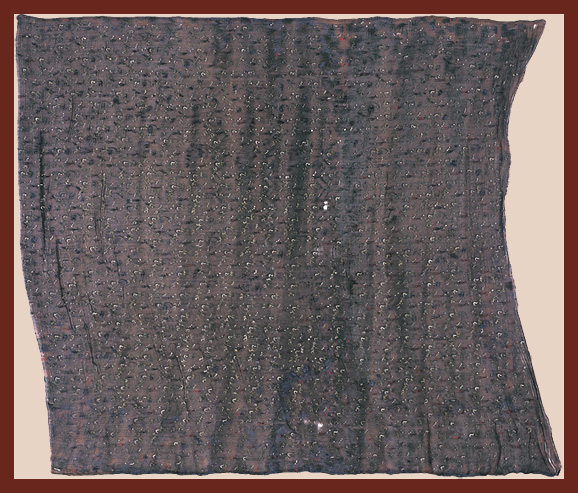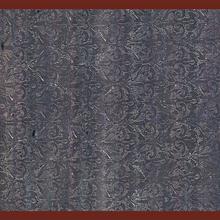Dimensions: width: 44cm; length: 54cm
Origin: Unearthed from Han Tomb No.1 at Mawangdui, Changsha City, Hunan Province.
The gauze with printed and painted design is the earliest silk fabric discovered in the world that combines printing and color painting. It is made, through the combination of printing and color painting, by applying printing and dyeing technique onto light and thin tabby silk fabric. This was a material used for the magnificent fashion dresses worn by noble ladies of that time.
There are about five colors used for printing and color painting, among which the better preserved colors are vermillion, chalk white and black. The design is a transformed liana plant, formed by its vines, buds, flower spikes and leaves, and its outer contour is a lozenge. Each unit of design is fairly small, only 4 centimeters long and 2.4 centimeters wide. And the units are all connected with each other on four sides. There are altogether 22 units of design. The vines are presented by coiled line and there are obvious breaks in the connecting section between the units, proving these designs were printed. The painted buds, flower spikes and leaves have evidence of the application of brush.
According to the analysis of the design and to simulation experiments, when the vine part was printed, four units were put together to form one larger plate – one 8 centimeter long and 4.4 centimeter wide big lozenge. If we calculate on the basis of 48 centimeters as the width of the fabric, each meter totals over 800 units and requires more than 200 times of printing. After the vine motif is printed on the fabric, the next thing to do is painting, which again can be divided into six steps: (1) paint out the spikes with vermillion, (2) pinpoint out the ovary of the spikes with thick black ink, (3) paint out the light silver-gray leaves, buds and dots, (4) paint out the warm gray-colored leaves and petals of the buds, (5) paint out the cold gray-colored leaves, and (6) use chalk white to sketch and add dots.
According to analysis, to make the processing steps easier, the fabric had to be dyed and smoothed first and marked with positions before it was printed. Consequently, the printing shows good permeability and full-grown lines, and there is no overlapping or uneven distribution between the units. Such gauze is undoubtedly a masterpiece of printing and dyeing of outstanding technological level by the ancient Chinese.



